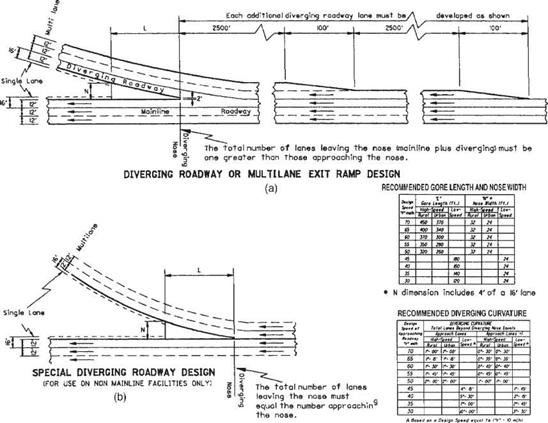Multilane Exit Ramps and Diverging Roadways
Figure 2.47 shows recommended designs for multilane exit ramps and diverging roadways. A diverging roadway is defined as a single roadway that branches or forks into two separate roadways without the use of a speed change lane.
Class I and II diverging roadways should be used when either or both the diverging roadways are mainline roadways of an expressway or a freeway. Class III diverging roadways should be used at the divergence of directional ramps within an interchange or at the divergence of ramps with non-limited-access roads or streets. In general, class III is applicable at all locations other than those requiring class I or class II.
Lane Balance and Continuity. To have lane continuity, the number of mainline lanes leaving the diverging nose must be equal to the number of mainline lanes approaching the nose. The total number of lanes leaving the diverging nose (mainline lanes plus diverging lanes) must be 1 greater than the total number of lanes approaching the nose to obtain lane balance. The purpose of obtaining lane continuity and lane balance is to avoid a drop lane situation.
It may be necessary to obtain lane balance by adding additional lanes upstream from the diverging nose. The length of each additional lane should be 2500 ft (762 m) and should be introduced using a 0- to 12-ft (3.7-m) taper of 100 ft (30 m) as recommended in Fig. 2.47 for the approach roadway class and design speed. There may be conditions off the mainline, such as on collector-distributor roads or within interchanges, where lane balance and continuity are less important. In such cases, the special diverging roadway design shown in Fig. 2.47 b may be used.
Terminal Design. The design of diverging roadway terminals is determined by the class and design speed of the approach roadway, and is based on the required neutral gore length L and the required nose width N. Figure 2.47 includes recommended length L and nose width N for various design speeds in diverging roadway classes.
Horizontal Curvature. The inset table in Fig. 2.47 lists recommended values for the diverging curvature (curve differential) between the outer pavement edges of diverging roadways. These values apply only when the alignment between the diverging nose and the PC of the diverging curvature is on tangent or simple curvature. When compounded or spiral curvature is used in the diverging area, it will be necessary to design diverging roadway alignments individually to provide proper L and N for the approach roadway class and design speed.
|
|
Crest Vertical Curves. When a diverging nose is located on a crest vertical curve, the curve should be designed using the design speed of the approach highway and a stopping sight distance value 25 percent higher than shown in Table 2.18.
Superelevation and Joint Location. The superelevation rate should be based on the design speed of the approach roadway. Superelevation in the terminal area should be designed in accordance with the guidelines given for single-lane ramp terminals (Art. 2.5.2). Longitudinal joints should be located so they will coincide with and define the lane lines.
2.7.2 Four-Lane Divided to Two-Lane Transition
Figure 2.48 shows a reversed curve design (types A and B), a tapered design (type C), and a design for a transition on a curve (type D) for achieving a four-lane divided to two-lane transition. The pavement transition should be located in an area where it can easily be seen. Intersections or drives should be avoided in the transition area. Vertical or horizontal curves should provide preferred stopping sight distance. Reverse curve transitions should normally be used for median widths of 20 ft (6 m) or wider. Taper lengths are based on the design speed of the mainline and are calculated from Eq. (2.5).







Leave a reply